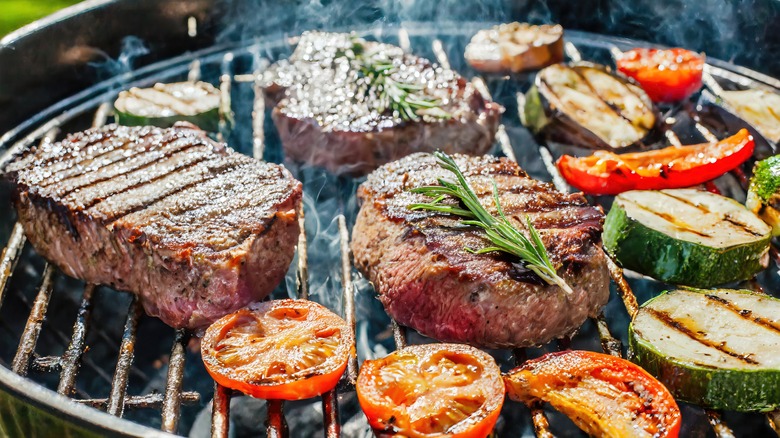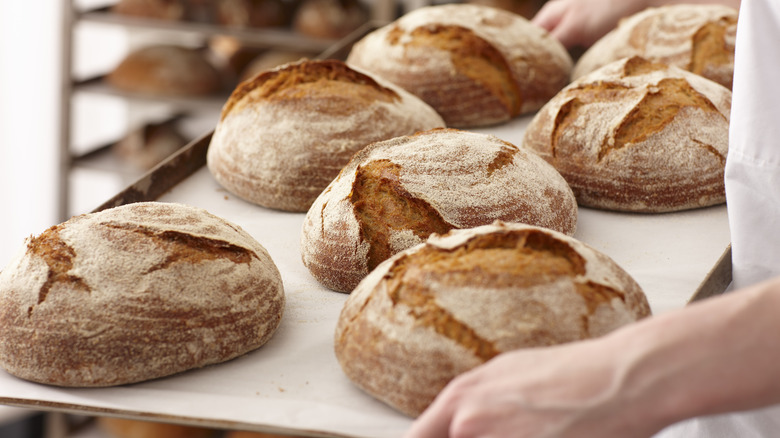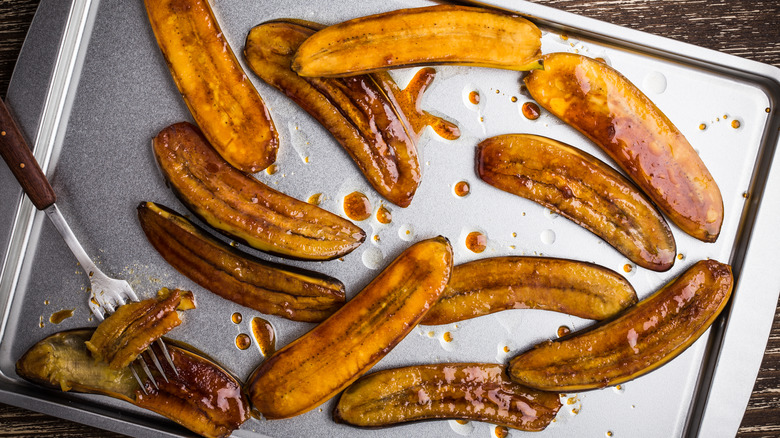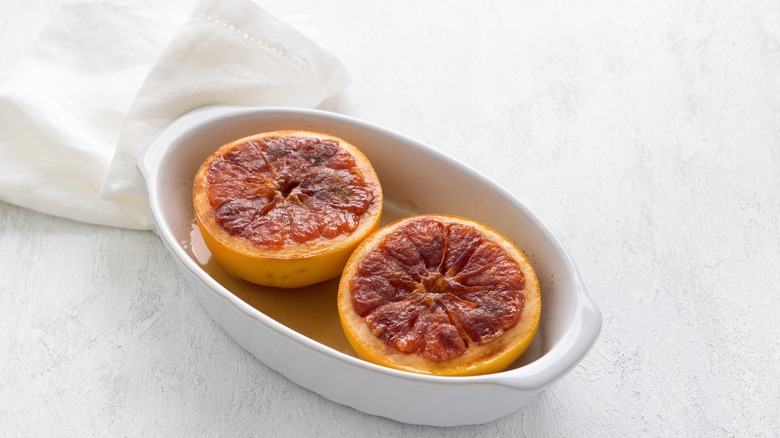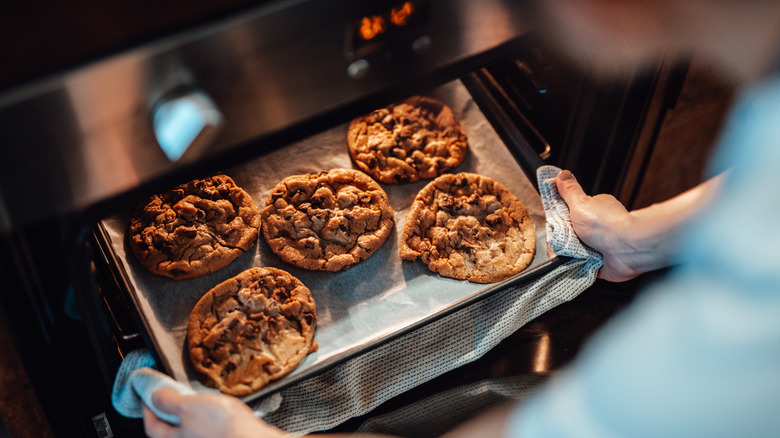What's The Difference Between The Maillard Reaction And Caramelization?
When preparation is going smoothly and the food smells delicious, it's easy to forget that cooking is chemistry. Employ a culinary technique — whether it be with heat or acid — and a complex set of reactions takes place, altering the composition of a foodstuff to a (hopefully) tasty state. While it's not essential to know all the details, extra guidance does enhance the result.
Two especially powerful processes to note are the Maillard reaction and caramelization. Both crucially contribute to food's delicious qualities, but navigating the distinctions between them is tricky. Thankfully, Kantha Shelke, Ph.D., CFS (Certified Food Scientist), who can be found on LinkedIn, lended Chowhound her expertise. She boasts some impressive accreditation to her name: the principal of Corvus Blue LLC (a food science and research firm), a food science communicator at the Institute of Food Technologists (IFT), and a senior lecturer of food safety regulations at Johns Hopkins University.
In her exclusive explanation, Shelke succinctly delineates the details of the two reactions — in short, they each occur with a distinct compound and in different circumstances. When it comes to the Maillard reaction, she says it's all about the release of savory flavors due to the interactions of amino acids and sugars. Meanwhile, caramelization only transforms sugar, releasing sweeter notes as a result. And when it comes to the cooking logistics themselves, Shelke notes, "[the] Maillard reaction occurs at slightly lower temperatures than caramelization." Both are multifaceted processes that affect food in fascinating ways.
What is the Maillard reaction?
The Maillard reaction is a delectable transformation; it imparts an appetizing quality to a wide range of foods. In casual terms, we simply refer to it as browning. Any drastic changes in color and taste occur by way of two compounds being affected in unison. "The Maillard reaction is a reaction between amino acids (from proteins) and sugars," Kantha Shelke says. Whether it's toast, roasted chicken, coffee beans, golden pancakes, or perfectly browned ground beef, all such foods undergo the tasty effects of the Maillard reaction when heated.
Chemically, the process creates what Shelke describes as "brown pigments called melanoidins, which add rich, savory flavors." In addition, the Maillard reaction releases pleasing aromas, too. Its effects are intensive, reforming the molecular structure. So, the appetizing qualities of taste and smell in browned food are in fact molecularly founded.
As with other chemical reactions, a plethora of initial criteria must be met for this browning to take place. Not all sugars are affected by the Maillard reaction; only reducing sugars, like the simple-structured types of lactose or glucose, transform. And crucially, there needs to be intensive heat. "A relatively high temperature typically above 140°C (280°F) [is necessary] to trigger the chemical reaction," explains Shelke. So, turn the stove to high and throw on the foodstuff, the Maillard reaction will craft a tasty result.
What is caramelization?
The word caramelization is a frequent colloquial expression; you'll likely associate it with dessert-making. Yet, in addition to dessert contexts, it's also a scientifically defined concept affecting other foods. Of caramelization, Kantha Shelke explains, "Sugars break down at high temperatures and form brown compounds like caramelans, caramelens, and caramelins." Also occurring under heated conditions, it's a similar process to the Maillard reaction, but with distinct results.
Caramelization transforms specifically carbohydrates, mainly sugars like fructose and sucrose found in fruits and vegetables. Unlike the Maillard reaction, Shelke notes that amino acids aren't required for caramelization. While sweet applications like making caramel with condensed milk may come to mind, caramelization also occurs when baking bread or deep-frying. Although the process occurs by way of hydrolysis — a term meaning water's a vessel for the reaction, per Britannica – you'll need a dry, hot environment to caramelize food.
The reaction also requires a steep temperature: About 320 degrees Fahrenheit when you're using standard sugar; quite a bit higher than with the Maillard reaction. And there's a required patience, too — the duration to see effects varies. Nevertheless, it's a reaction that occurs frequently, coloring and flavoring many dishes with an appetizing quality.
The Maillard reaction and caramelization produce distinct culinary features
While both reactions involve heating sugar, they're different in their resultant character. In terms of flavor, the effects are easy to differentiate. Kantha Shelke says, "[The] Maillard reaction produces complex, savory flavors, while caramelization yields a sweeter, caramel-like taste." However, as chefs will know, there's lots to note in the nuance.
Since the Maillard reaction involves the protein composition, the transformation drastically varies based on the food. The roasted grains that contribute to the perfect crusty bread for bruschetta is a different culinary experience to the sizzle of a seared steak. Furthermore, the savory taste is a subjective note: Richness manifests in different ways. Not to mention the Maillard reaction produces aromas that can be distinct from a food's flavors, further enhancing a dish.
Caramelization is more straightforward in its culinary effect. Shelke points out the "characteristic caramel flavor" that diners are familiar with is a hallmark of the reaction. The caramelized taste may be easy to pinpoint, but it carries a deceptively complex palate. Transform the initially sweet-tasting sugar and you'll detect notes of nuttiness or even bitterness. It's a quintessential flavor in many dishes, like melted caramel coatings for apples. However, caramelization behaves differently in other contexts, too, like with aptly named caramelized onions. Although the utilized ingredients are distinct in flavor, they're united in the transformation of the chemical process.
The two separate reactions can work in unison
While the contrast between the two processes is apparent; there's power in their combined coalition, too. Both the Maillard reaction and caramelization transform fundamental flavor compounds, and sometimes in compatible ways. Kantha Shelke says, "Both are non-enzymatic browning reactions that depend on temperature and can happen in parallel." Even in their chemical composition, there's overlap.
Many foods involve complex chemical compounds, often both sugars and proteins, so their reactions can complement each other, transforming in equal measures of savory and sweet. Shelke points out that a steak is a great example of the processes occurring in tandem. "The browning on the surface happens because of both, she says. The crust is colored and flavored by the Maillard reaction affecting the meat's protein as caramelization transforms its natural sugars.
Depending on the dish, one reaction can take precedence. If you examine a baking cookie, both reactions occur, but since the sweet treat contains less protein, caramelization is more predominant. Just don't confuse them as the same function. "They are distinctly different chemical processes with different requirements," Shelke notes. Now knowing what contributes to each of them, you'll hold more insight into how your food is changing as it cooks.
